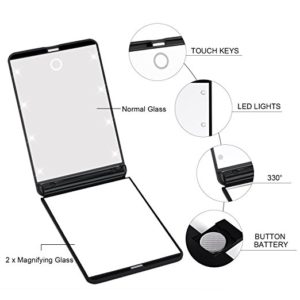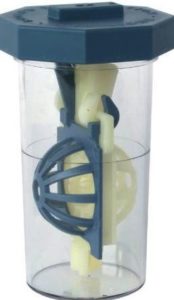Today marks ten years since I awoke from microvascular decompression surgery to left-side facial paresis. Well, paralysis at that time. Single-sided deafness as well. Fortunately over time I regained most of my balance and hearing and enough facial function that most people don’t notice anything amiss. My blink and tear function have never returned, so I have spent a decade finding a remedy for painful dry eye. The solution that has worked best for me is the combination of an implanted eyelid weight and scleral contact lenses. These large-diameter specialty lenses are expensive and require quite a bit of maintenance, but in my opinion are worth every bit of cost and effort.
In past posts I outlined the care routine that works best for me. Since then I’ve discovered a couple more items that make it more manageable.
Several months ago I had to have my collarbone plated following an auto accident. Something went wrong with the nerve block and for a while my left arm did not function. My insertion technique requires both hands – one to hold the inserter and lens, the other to hold my eyelid wide open. For the first couple of weeks my husband helped with the eyelid part. We were both relieved when I regained the minimal movement and grip necessary to hold the inserter relatively steady. It was frustrating at first. My left hand did not have the strength to hold my eyelids, so I could only use it to hold the inserter and lens. Fine for my right side, but very awkward for the left. It wasn’t what I was used to and I kept bumping into my nose moving my right hand across my face to open the left eyelids. The weakness in my left hand caused me to spill the solution quite often. I also had a hard time aligning the left lens in the mirror I used on the counter. I was back to needing ten to fifteen minutes or more just to insert my contacts.
I remembered seeing a scleral insertion system that incorporated a lighted stand, but remembered it as pricey. I also didn’t want to have to wait on shipping. I thought about my craft light box but couldn’t find it, so we went to Hobby Lobby to see what they might have. A store employee directed us to this:
I snapped it up with a 40% off coupon and it worked like a charm. All I needed to do was align the inserter so that I could see a little circle of light. This lasted for a few weeks before it died. I think that even though I blotted up excess saline right away, some made its way into the box and shorted its circuits. In retrospect, I should have put a square of glass or plastic over it to keep the liquid out.
No worries though – since the concept worked so well I wondered if combining lights with a mirror I had been using wouldn’t be any better. I started searching at Amazon.com and found this lighted compact:
I highly recommend this for people who have trouble inserting their lenses. I find that it helps immensely to align lenses properly, plus it’s inexpensive and small enough for travel.
Before I regained normal strength and dexterity in my hand, I reverted to using disinfecting solution rather than ClearCare. I did not want to run the risk of snapping a lens, even having moved to PROSE cases with their larger baskets. As soon as I was able, I switched back to ClearCare, but there is a drawback. I have two pairs of lenses that I switch between every other day. Because the hydrogen peroxide system doesn’t seal, when I travel there is a risk of spilling the solution out of the second case. Before our most recent hiking trip to South Dakota, I made an exciting discovery. The PROSE case exactly fits into an empty eye makeup remover jar. (The labels peel off easily.)
Make sure it’s the extra-large 120-count jar. The 80-count is too short for the PROSE case, but might work with a ClearCare case. While a little solution may still seep into the jar, it won’t leak out into luggage.
It amazes me to look back and see how far scleral lens technology and use has come in the past decade. I’m looking forward to seeing what the next ten years bring.




